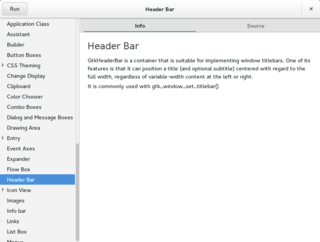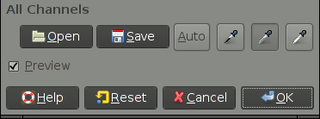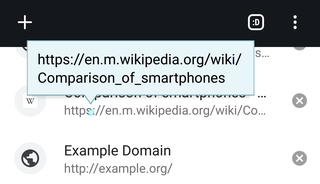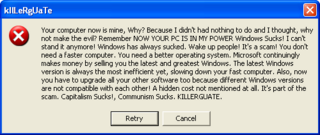Related Research Articles
AppleScript is a scripting language created by Apple Inc. that facilitates automated control over scriptable Mac applications. First introduced in System 7, it is currently included in all versions of macOS as part of a package of system automation tools. The term "AppleScript" may refer to the language itself, to an individual script written in the language, or, informally, to the macOS Open Scripting Architecture that underlies the language.

In computing, a dialog box is a graphical control element in the form of a small window that communicates information to the user and prompts them for a response.
In user interface design, a modal window is a graphical control element subordinate to an application's main window.

Swing is a GUI widget toolkit for Java. It is part of Oracle's Java Foundation Classes (JFC) – an API for providing a graphical user interface (GUI) for Java programs.
In user interface design, a menu is a list of options presented to the user.

A graphical widget in a graphical user interface is an element of interaction, such as a button or a scroll bar. Controls are software components that a computer user interacts with through direct manipulation to read or edit information about an application. User interface libraries such as Windows Presentation Foundation, Qt, GTK, and Cocoa, contain a collection of controls and the logic to render these.
Common User Access (CUA) is a standard for user interfaces to operating systems and computer programs. It was developed by IBM and first published in 1987 as part of their Systems Application Architecture. Used originally in the MVS/ESA, VM/CMS, OS/400, OS/2 and Microsoft Windows operating systems, parts of the CUA standard are now implemented in programs for other operating systems, including variants of Unix. It is also used by Java AWT and Swing.
Open Programming Language (OPL) is a programming language for embedded systems and mobile devices that run the operating systems EPOC and Symbian. It was released by the British company Psion in 1984.
An alert dialog box is a special dialog box that is displayed in a graphical user interface when something unexpected occurred that requires immediate user action.

In computing, a button is a graphical control element that provides the user a simple way to trigger an event, like searching for a query at a search engine, or to interact with dialog boxes, like confirming an action.

The tooltip, also known as infotip or hint, is a common graphical user interface (GUI) element in which, when hovering over a screen element or component, a text box displays information about that element, such as a description of a button's function, what an abbreviation stands for, or the exact absolute time stamp over a relative time. In common practice, the tooltip is displayed continuously as long as the user hovers over the element or the text box provided by the tool. It is sometimes possible for the mouse to hover within the text box provided to activate a nested tooltip, and this can continue to any depth, often with multiple text boxes overlapped.

Tkinter is a Python binding to the Tk GUI toolkit. It is the standard Python interface to the Tk GUI toolkit, and is Python's de facto standard GUI. Tkinter is included with standard Linux, Microsoft Windows and macOS installs of Python.

Windows Aero is the design language introduced in the Microsoft Windows Vista operating system. The changes introduced by Windows Aero encompassed many elements of the Windows interface, with the introduction of a new visual style with an emphasis on animation, glass, and translucency; interface guidelines for phrasing and tone of instructions and other text in applications were available. New cursors and sounds based on Windows Aero design principles were also introduced.
Dialog Control Language (DCL) is a high-level description language and interpreter within AutoCAD for creating simple graphical dialogs. AutoLISP extensions use it to interact with the user in the AutoCAD environment.

qooxdoo is an open-source Ajax web application framework. It is an LGPL- and/or EPL-licensed client-side and server-agnostic solution, and includes support for professional JavaScript development, a graphical user interface (GUI) toolkit and high-level client-server communication.

A mouse button is an electric switch on a computer mouse which can be pressed (“clicked”) to select or interact with an element of a graphical user interface. Mouse buttons are most commonly implemented as miniature snap-action switches.

Zenity is free software and a cross-platform program that allows the execution of GTK dialog boxes in command-line and shell scripts.

Kivy is a free and open source Python framework for developing mobile apps and other multitouch application software with a natural user interface (NUI). It is distributed under the terms of the MIT License, and can run on Android, iOS, Linux, macOS, and Windows.

Gruel, also referred to by F-Secure as Fakerr, was a worm first surfacing in 2003 targeting Microsoft Windows platforms such as Windows 9x, Windows ME, Windows 2000 and Windows XP. It spread via email and file sharing networks.
References
- ↑ "gui design - Is "Chicken Box" an appropriate term for a Yes/No dialogue with a warning?". User Experience Stack Exchange. Retrieved 2023-05-11.
- 1 2 Java Look and Feel Design Guidelines, Alert Boxes
- ↑ Microsoft GUI guidelines
- ↑ BlackBerry GUI guidelines